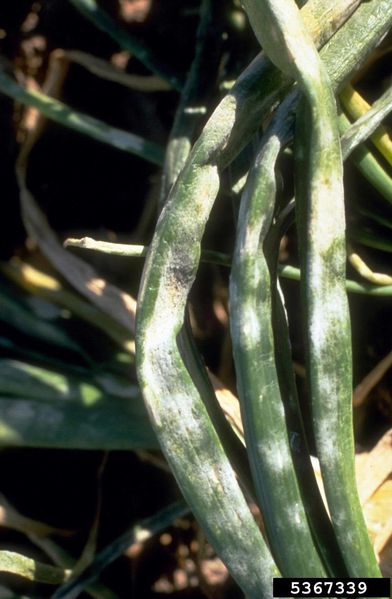About Powdery Mildew on Onions
Powdery mildew on onions is a fungal disease caused by the pathogen Leveillula taurica. While the disease commonly called powdery mildew can affect thousands of different plant varieties, there are actually different pathogens that cause the disease in specific plants. Leveillula taurica is a powdery mildew pathogen that specifically infects plants in the Allium family. This can play an important role in selecting the proper fungicides for onion powdery mildew control. It is always important with fungicides to thoroughly read the label before purchasing and using these products. In this case, you will want to select a fungicide that states it specifically treats Leveillula taurica or onions with powdery mildew. Using products that do not specifically state this may not only be a waste of money, but it could cause harmful side effects and not be safe for edibles. That being said, symptoms of powdery mildew on onions are pretty much the same as symptoms of any powdery mildew. The first, often unnoticed, symptom is light green, yellow, or chlorotic looking spots or mottling on onion foliage. As the disease progresses, these spots can become slightly sunken and turn a white to light gray color. A powdery white substance will form on these lesions and can eventually coat entire leaves or blades. This powdery white coating is the disease’s mycelium which contains spores. The spores are usually released on to the wind or can spread by rain or overhead watering.
Onion Powdery Mildew Control
Powdery mildew on onions is most prevalent in the hot, dry conditions of summer months that have followed cool, wet spring weather. The disease can overwinter in garden debris or on the soil surface and can be transferred to new plants by splash back of rain or watering. The fungus then enters plants through their microscopic stomata and begins to grow. As summer heats up, the conditions become perfect for spore production, and this is when we generally notice the obvious powdery white symptoms of the disease. As with any fungal disease, proper sanitation can greatly reduce the spread of powdery mildew on onions. Cleaning up garden debris, sanitizing tools, and deeply tilling garden beds at the beginning of each new planting season are beneficial steps in onion powdery mildew control. It is also important to not overcrowd garden beds. Preventative fungicides which contain potassium bicarbonate, or just some kitchen baking soda, can also prevent the spread of Leveillula taurica. While many fungal diseases cannot be treated with fungicides once the disease is present, onion powdery mildew can be treated with certain fungicides. Be sure to read fungicide labels to select one that will treat this condition.
